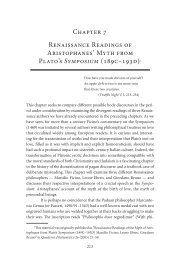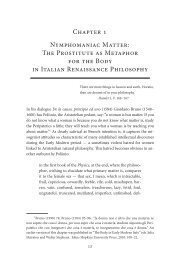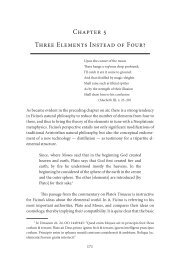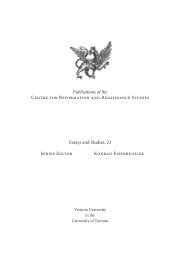Chapter 2 Matter as a Mirror: Marsilio Ficino and Renaissance ...
Chapter 2 Matter as a Mirror: Marsilio Ficino and Renaissance ...
Chapter 2 Matter as a Mirror: Marsilio Ficino and Renaissance ...
You also want an ePaper? Increase the reach of your titles
YUMPU automatically turns print PDFs into web optimized ePapers that Google loves.
100<br />
Disreputable Bodies<br />
dition of all sort of optical tricks involving mirrors; for example to let ghosts<br />
appear on stages. 161 As we had occ<strong>as</strong>ion to notice, the mirror’s transforming<br />
powers underscore the idea that it does not merely reflect the object itself, but<br />
creates a new <strong>and</strong> structurally deceptive image of the object.<br />
Since Antiquity the mirror w<strong>as</strong> believed to have the capacity to<br />
convey knowledge of things divine. As such, it could be both an instrument<br />
of self-knowledge <strong>and</strong> the receptacle of diabolic or destructive forces. This<br />
ambivalent attitude w<strong>as</strong> also present in the <strong>Renaissance</strong> (<strong>and</strong> indeed, later<br />
on): the mirror w<strong>as</strong> an image of deterioration, <strong>as</strong> a screen, a focusing lens,<br />
an instrument of deception, a magical object, an image of vanity or selfcognition.<br />
162 In <strong>Renaissance</strong> art, the mirror served <strong>as</strong> an allegory for virtue<br />
(Prudence) <strong>as</strong> well <strong>as</strong> for vice (Superbia). In the very early 1500s, just a few<br />
years after <strong>Ficino</strong>’s death, the Netherl<strong>and</strong>ish painter Hieronymus Bosch, in<br />
his “The Garden of Earthly Delights” (Prado, Madrid), included a woman<br />
looking into a mirror that is nothing more than the rear end (to use a euphemistic<br />
English expression) of a devil, thus illustrating the equally explicit<br />
French proverb Le miroir est le vrai cul de diable.<br />
It w<strong>as</strong> precisely this ambiguous nature of mirrors that made them<br />
magical tools par excellence, instruments that were used to summon de-<br />
[…] imagines indicat resupin<strong>as</strong> […]. Proinde cum radius visualis intuitus speculum illinc<br />
obiecta plurima reflectatur eaque prospiciat per pares videlicet incidentiae reflexionesque<br />
(ut ferunt) angulos simulque eorum imagines attingat in speculis. Cur non circa idem duo<br />
quaedam sibi videatur idola contueri? Quia videlicet perfecta quadam imaginis ad obiectum<br />
similitudine fallitur. Fallitur quinetiam rem obiectam putans esse duntaxat in speculo<br />
ubi eius intuetur imaginem: imagines qu<strong>as</strong>dam e speculis resultare, & si nonnulli negant:<br />
Theopr<strong>as</strong>tus tamen in libris de anima, ut Iamblichus et Priscianus exponunt, cum Platone<br />
consentit: Et Proclus in sexto de Republica probat.” For the p<strong>as</strong>sage on distorting mirrors,<br />
see Timaeus 46A <strong>and</strong> Lucretius (1994) IV, 311: 103.<br />
161 Hero (1899–1911) p<strong>as</strong>sim.<br />
162 Frontisi-Ducroux (1998) 122 comes to similar conclusions about the function of<br />
the mirror in Cl<strong>as</strong>sical Greece: “tantôt projecteur, tantôt instrument d’exploration interne,<br />
le plus souvent récepteur de ce qui vient d’en face, il est aussi p<strong>as</strong>sage ou lieu d’émergence<br />
de ce qui sans lui resterait inaccessible.” See also, 59–62. On the one h<strong>and</strong>, the mirror effeminates<br />
<strong>and</strong> depersonalizes men; for a free male Greek citizen it w<strong>as</strong> disgraceful to use a<br />
mirror in private. On the other h<strong>and</strong>, Socrates recommended the mirror <strong>as</strong> an instrument<br />
for self-cognition; see Diogenes Laertius (1925) II, 33; an opinion Seneca shares (1971–2)<br />
I, 17, 4, 6.







